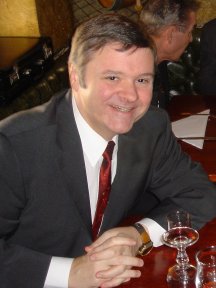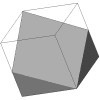

Look up a number sequence in the On-Line Encyclopedia of Integer Sequences
by typing consecutive numbers from your sequence of interest (signs are optional):SeqFan Mailing List (French or English) maintained by Olivier Gérard for integer sequences fans.
OEIS 100K E-Party: To celebrate the A100000 milestone in November 2004, N.J.A. Sloane opened
the gates to an electronic party featuring pictures of collaborators, contributors and fans of the OEIS.
At that point, Sloane had kept the project alive for 40 years with incredible stamina and daily dedication.In 2009, Sloane transferred his rights to the encyclopedia to the newly created OEIS foundation,
thus ensuring the perennity of this incredible asset for future generations of mathematicians.
The OEIS was hosted by Sloane's employer (AT&T) until 2010.Neil Sloane himself retired from AT&T in 2012 but remains president of the OEIS foundation.
He still participates in the daily development of the encyclopedia and calls the shots
in the delicate cases where even the most senior OEIS editors need guidance.I'm just an occasional OEIS contributor but I've linked to it more than 400 times in Numericana.
I'm still proudly claiming (tongue-in-cheek) a 0.02% "ownership" of the OEIS.
However, the accelerating OEIS development has reduced the true figure to less than 0.01%.
Here are my contributions:
- A217592 (2012-10-28) Integers cut in half by rotating their digits left.
- A162512 (2009-07-05) Multiplicative function: a(p^e) = -(-2)^(e-1)
- A162511 (2009-07-05) Multiplicative function: a(p^e) = (-1)^(e-1).
- A162510 (2009-07-05) Multiplicative function: a(p^e) = 2^(e-1).
- A160679 (2009-06-25) Square-roots of nimbers.
- A160678 (2009-06-06) Numbers n whose abundancy s(n)/n is 13/2.
- A160115 (2009-05-06) Fluctuations in the number of cubefree integers (binary).
- A160114 (2009-05-06) Fluctuations in the number of cubefree integers (decimal).
- A160113 (2009-05-02) Number of cubefree integers with n bits.
- A160112 (2009-05-02) Number of cubefree integers with n digits.
- A143314 (2008-08-06) Poker hands of n cards containing a straight flush.
- A141385 (2008-07-02) A sequence obeying a third-order linear recurrence.
- A141384 (2008-06-28) Traces of the powers of an order-8 adjacency matrix.
- A140076 (2008-06-01) Pierce expansion of the cube root of 1/2.
- A140074 (2008-05-06) Excess count of the perfect squares between cubes.
- A129667 (2007-04-28) Dirichlet inverse of the Abelian group count.
- A120630 (2006-06-24) Dirichlet inverse of ¼ card( {(x,y) | x2+y2 = n} )
- A120629 (2006-06-20) Nonpowers < 0, with squarefree part ¹ 1 mod 4.
- A108942 (2005-07-20) Obsolete. See note below.
- A101188 (2004-12-08) (7m+1)(8m+1)(11m+1) is a Carmichael number.
- A101187 (2004-12-03) (6k+1)(12k+1)(18k+1) is a Carmichael number.
- A101186 (2004-12-03) m=1848+942k makes 7m+1,8m+1,11m+1 prime.
- A101088 (2004-11-30) Prime values of | B101086(k) |.
- A101087 (2004-11-30) Values of k for which | B101086(k) | is prime.
- B101086 (2004-11-30) a(0) = 0; a(1) = 1; a(n+2) = a(n+1) - 2 a(n).
- A101035 (2004-11-27) Dirichlet inverse of the gcd-sum function.
- A058789 (2000-11-30) n-hedra with n+1 vertices (and/or 2n-1 edges).
- A058788 (2000-11-29) Table: Polyhedra with n edges and k nodes.
- A058787 (2000-11-29) Table: Polyhedra with n faces and k vertices.
- A058786 (2000-11-29) n-hedra with 2n-5 vertices (and/or 3n-7 edges).
In addition, I had a few comments to make on sequences contributed by others:- A002879 (2013-11-14) Best 5-card poker hands extracted from 7-card combos.
- A128857 (2012-10-31) Decimal period of the fraction n/(10n-1).
- A128858 (2012-10-30) Length of the above: a(10) = 2 (not 4).
- A146088 (2012-10-28) Integers that are doubled by rotating theirs digits right.
- A048943 (2010-10-10) Characterizing integers whose divisor product is square.
- A162530 (2009-07-12) A few more terms in an easy sequence.
- A159271 (2009-07-01) Numbers of abundancy 11/2. Table & factorizations.
- A088912 (2009-06-10) Guy Robin's theorem (1984) & Riemann's hypothesis.
- A055153 (2009-06-04) 88898072401645056 has abundancy 7/2.
- A077006 (2009-05-20) 360360 ties the record abundancy (48/11) of 332640.
- A055153 (2009-05-10) 22290964134962716779872256 has abundancy 7/2.
- A141645 (2009-05-10) 200286975596707184640 has abundancy 9/2.
- A004709 (2009-05-06) Cubefree integers.
- A071172 & A053462 (2009-04-30) Squarefree integers with fewer than n digits.
- A143658 (2009-04-30) Number of squarefree integers with n+1 bits or less.
- A048954 (2009-01-16) Factorization of Wn (up to n=114, as of 2007-11-11).
- A003277 (2008-01-08) These are all the divisors of Carmichael numbers...
In one case, someone else quoted me as the sole source for a new OEIS entry:- A194282 (2011-08-22) Variant of the even lucky numbers.
Notes :
A108942 (which is now an unrelated sequence) was created on 2005-07-20 by Jonathan Vos Post (whom I befriended electronically only much later) as a home for the finite sequence (0,1,2,3,4,5,6,7,9,18,33). Jonathan posted that with a reference to an article of mine and a piece of prose cut-and-pasted from it (his motivations are explained elsewhere). On 2009-10-24, Maximilian F. Hasler pointed out that the thing had already been filed much earlier as A007496, which is where the aforementioned prose can now be found (incidentally, I ended up befriending Maximilian 6 years later for unrelated reasons and he helped with a page on Wendt determinants). This goes to show that almost every "cute" sequence is likely to be already part of OEIS. Read before you write!
The simple sequence listed above as B101086 is not part of OEIS, although it was submitted at the indicated date, because it differs from two previously listed sequences (A001607 and A077020) by signs only. Yet, that sequence has the simplest closed form among its siblings. Originally, the EIS (not yet "Online") was essentially devised as a collection of unsigned sequences (in the early printed versions, the lexicographic organization of the integer sequences was insensitive to signs). This historical bias is still present in the current OEIS. For example, I submitted A120629 as a sequence consisting entirely of negative values (arguably, that's the best way ro present it). It was immediately retitled and recorded as a sequence of absolute values, which now stands...
At last count (2022-11-11) there are 493 references to the OEIS in 65 distinct Numericana pages:
 |
 Gérard P. Michon, Ph.D. |
 |
Neologisms:Here are the neologisms I coined (I don't know where else to put this list).
|
 Hemicube |
|
| The above list is mostly for my own records, but it might help others trace the origins of words. | ||